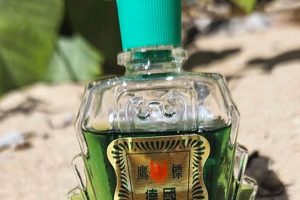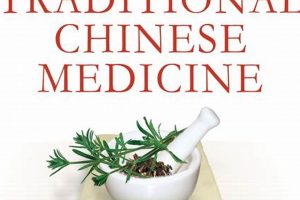Formulations involving the combination of various Chinese medicinal herbs prepared as a beverage are a common practice in traditional Chinese medicine. These preparations are designed to address specific health concerns or promote general well-being through the synergistic effects of their individual components. For instance, a combination of chrysanthemum, honeysuckle, and mint may be employed to alleviate symptoms associated with heat or inflammation.
The practice of using herbal decoctions for therapeutic purposes has a long history in Chinese culture, with roots extending back thousands of years. These beverages are valued not only for their potential health benefits, such as promoting detoxification, supporting immune function, and aiding digestion, but also for their cultural significance as a means of maintaining balance and harmony within the body according to traditional principles. Their preparation is often considered an art form, requiring a deep understanding of the properties of individual herbs and their interactions.
The subsequent sections will delve into the principles of selecting appropriate ingredients, the methods of preparation and consumption, and the consideration of individual health conditions when incorporating these herbal drinks into a health regimen. Further discussion will also include safety precautions and potential contraindications associated with various herbal combinations.
Guidelines for Preparing Herbal Infusions
The following guidelines are designed to provide essential information for the safe and effective preparation of traditional Chinese herbal infusions. Strict adherence to these recommendations is crucial for maximizing benefits and minimizing potential adverse effects.
Tip 1: Ingredient Sourcing: Procure all herbal ingredients from reputable suppliers committed to quality control and authentication. Adulterated or misidentified herbs can lead to unpredictable and potentially harmful consequences.
Tip 2: Dosage Adherence: Precisely follow the recommended dosages specified in established and reliable sources. Deviation from prescribed quantities can alter the therapeutic effect or increase the risk of toxicity. Consult a qualified practitioner for personalized dosage recommendations.
Tip 3: Preparation Method: Employ the appropriate method of preparation as dictated by the specific combination of herbs. Some herbs require prolonged simmering to extract their active compounds, while others are best consumed as a short infusion to prevent degradation of volatile oils.
Tip 4: Water Quality: Utilize filtered or purified water for the preparation. Impurities present in tap water can interact with certain herbs, potentially affecting their efficacy or safety.
Tip 5: Storage Conditions: Properly store prepared infusions in a cool, dark place and consume within a specified timeframe (typically 24-48 hours) to prevent spoilage and maintain optimal potency. Refrigeration is generally recommended.
Tip 6: Contraindications Awareness: Be acutely aware of any contraindications associated with individual herbs or the combination as a whole. Certain herbs are not suitable for pregnant or breastfeeding women, individuals with specific medical conditions, or those taking certain medications.
Tip 7: Monitoring for Adverse Effects: Closely monitor for any adverse effects following consumption, such as gastrointestinal upset, allergic reactions, or changes in vital signs. Discontinue use immediately if any unusual symptoms occur and seek professional medical advice.
By adhering to these guidelines, individuals can significantly enhance the safety and effectiveness of traditional herbal infusions, facilitating the potential health benefits while minimizing the risk of adverse reactions. It is emphasized that professional guidance remains paramount, especially for those with pre-existing medical conditions or taking pharmaceutical medications.
The subsequent section will provide detailed insights into specific herbal formulations and their traditional uses, further expanding on the practical application of these principles.
1. Herb Properties
The efficacy and safety of any Chinese herbal tea depend intrinsically on the individual properties of the herbs employed in the formulation. Understanding these properties is paramount to achieving the desired therapeutic outcome while minimizing the risk of adverse effects. The following points outline several key facets of herb properties crucial to the creation of effective and safe formulations.
- Energetic Temperature ()
Traditional Chinese Medicine classifies herbs according to their energetic temperature, ranging from cold () to hot (). This property influences how the herb interacts with the body’s internal environment. For example, herbs with cooling properties, such as chrysanthemum (), are often used to address conditions characterized by heat, such as inflammation or fever. Conversely, warming herbs, like ginger (), can be beneficial for individuals experiencing coldness or deficiency. The careful selection of herbs based on their energetic temperature is essential for maintaining balance and avoiding imbalances that can exacerbate existing conditions.
- Flavor ()
The flavor of an herb, such as sweet, sour, bitter, pungent, or salty, provides additional insight into its therapeutic actions. Sweet herbs tend to tonify and harmonize, while sour herbs can be astringent and stabilizing. Bitter herbs often have drying and detoxifying effects. Pungent herbs promote circulation and dispel stagnation, and salty herbs can soften hardness and address accumulations. The flavor profile of an herb influences its affinity for specific organs and its ability to address particular imbalances. For instance, a bitter herb like gentian root () is often used to clear heat from the liver and gallbladder.
- Meridian Tropism ()
Meridian tropism refers to the specific meridians or organ systems to which an herb directs its therapeutic action. Each herb has a natural affinity for certain meridians, allowing it to exert its effects more directly and efficiently. For example, hawthorn berry () is known to enter the spleen, stomach, and liver meridians, making it useful for addressing digestive issues and promoting blood circulation in these areas. Understanding meridian tropism allows practitioners to target specific organ systems and tailor herbal formulas to address the root cause of an individual’s health concerns.
- Functions ()
The specific functions of an herb describe its therapeutic actions and the effects it produces within the body. These functions can range from tonifying Qi and blood to clearing heat, resolving dampness, or promoting blood circulation. For example, ginseng () is renowned for its ability to tonify Qi and strengthen the spleen, while licorice root () is known for its harmonizing properties and its ability to moisten the lungs. A thorough understanding of each herb’s functions is essential for selecting the appropriate ingredients and creating a formula that effectively addresses the individual’s specific health needs.
In conclusion, the properties of individual herbs energetic temperature, flavor, meridian tropism, and specific functions are foundational to the creation of effective and safe Chinese herbal tea formulations. A comprehensive understanding of these properties is crucial for achieving the desired therapeutic outcome, maintaining balance within the body, and minimizing the risk of adverse effects. This knowledge, combined with careful ingredient selection and appropriate preparation methods, allows for the creation of herbal teas that are both beneficial and tailored to individual needs.
2. Preparation methods
The efficacy of any chinese herbal tea recipe is inextricably linked to the specific preparation method employed. Preparation is not merely a procedural step, but rather a crucial process that directly influences the extraction of active constituents, thereby dictating the tea’s therapeutic potential. Inappropriate preparation can lead to insufficient extraction, rendering the tea ineffective, or conversely, can result in the release of undesirable compounds, potentially causing adverse effects. For example, certain roots and barks require prolonged decoction (simmering) to break down their cell walls and release their medicinal components. In contrast, aromatic herbs containing volatile oils may only require a brief infusion to prevent the evaporation of these beneficial compounds. A failure to recognize these distinct requirements undermines the entire purpose of the formulation.
Specific preparation techniques such as decocting, infusing, or macerating, are selected based on the properties of the herbs included in the formula. A decoction, involving prolonged simmering, is generally used for tougher materials like roots, seeds, and bark, ensuring the release of their active constituents. Infusion, on the other hand, is suitable for delicate leaves and flowers, where the focus is on extracting volatile oils and easily soluble compounds without excessive heat. Maceration, soaking herbs in cold water, is another method, used to extract certain compounds that may be damaged by heat. One could use a blend of ginseng and chrysanthemum. The ginseng root must be decocted to retrieve its potential ingredient but chrysanthemum only need a short time of infusion.
In summary, the selection of an appropriate preparation method is not an arbitrary choice but a critical determinant of the final product’s quality and therapeutic value. Understanding the distinct requirements of different herbal components is essential for realizing the intended benefits of a chinese herbal tea recipe. A mismatch between herb properties and preparation technique can nullify the formulation’s effectiveness, highlighting the necessity of a rigorous and informed approach to herbal tea preparation. This understanding directly links to the practical application of traditional knowledge in modern contexts.
3. Dosage accuracy
The precision of dosage is paramount in the preparation and consumption of any chinese herbal tea recipe. Deviations from established guidelines, whether through under- or over-dosing, can significantly alter the intended therapeutic outcome and potentially introduce adverse health consequences. Accurate dosage ensures that the herbal formulation delivers its intended benefits while mitigating the risk of toxicity or other unwanted effects.
- Therapeutic Efficacy
Precise dosage dictates the therapeutic efficacy of the herbal tea. Underdosing may result in a diminished or absent therapeutic response, rendering the formulation ineffective for its intended purpose. Conversely, overdosing can lead to an exaggerated effect, potentially causing discomfort or adverse reactions. For example, an insufficient quantity of licorice root in a formula may fail to adequately harmonize the other herbs, while an excessive amount could lead to fluid retention and elevated blood pressure in susceptible individuals.
- Safety Considerations
Adherence to recommended dosages is critical for ensuring the safety of herbal consumption. Overdosing can increase the risk of toxicity, particularly with herbs containing potent active compounds. Dosage accuracy is particularly important for individuals with pre-existing medical conditions or those taking pharmaceutical medications, as interactions between herbs and drugs can be influenced by the dosage of the herbal component. For instance, excessive consumption of certain herbs with anticoagulant properties could increase the risk of bleeding in individuals taking blood-thinning medications.
- Individual Variability
Dosage requirements can vary depending on individual factors such as age, body weight, constitution, and overall health status. Standardized dosage recommendations may not be appropriate for all individuals, and adjustments may be necessary to account for these differences. Children, the elderly, and individuals with compromised liver or kidney function may require lower doses due to their altered metabolism and excretion rates. A qualified herbalist or healthcare professional can assess individual factors and provide personalized dosage recommendations.
- Consistency and Standardization
Maintaining consistency in dosage is essential for achieving predictable and reliable results. Variations in the concentration of active compounds within different batches of herbs can affect the potency of the final product. Standardization of herbal extracts ensures that each dose contains a consistent amount of the active ingredient, improving the reproducibility of therapeutic effects. Accurate measurement techniques, such as using calibrated scales and measuring cups, are necessary for ensuring consistent dosage in home preparations.
Dosage accuracy is a cornerstone of safe and effective practice. Each facet, from therapeutic efficacy to individual variability, underscores the necessity for careful attention to detail and adherence to established guidelines. Ignoring this crucial aspect can undermine the potential benefits of herbal therapy and potentially expose individuals to unnecessary health risks. Precise dosage contributes directly to the reliability and predictability of herbal remedies, ensuring that they are used responsibly and effectively.
4. Ingredient sourcing
The quality and safety of any chinese herbal tea recipe are fundamentally contingent upon the source of its constituent ingredients. Ingredient sourcing is not merely a logistical consideration but a critical determinant of the tea’s therapeutic efficacy, safety profile, and overall quality. The provenance of herbs directly impacts their chemical composition, potency, and potential contamination levels, thereby influencing the health benefits and risks associated with their consumption.
- Authentication and Identification
Accurate authentication and identification of herbal ingredients are paramount for ensuring that the correct species and chemotype are used in the formulation. Misidentification or adulteration can lead to the substitution of an herb with a less effective or even toxic alternative. For example, Aristolochia species, which contain nephrotoxic compounds, have been mistakenly substituted for other herbs in some instances, resulting in severe kidney damage. Reputable suppliers employ rigorous quality control measures, including macroscopic and microscopic analysis, chemical fingerprinting, and DNA barcoding, to verify the identity and purity of their herbal products.
- Cultivation Practices
Cultivation practices significantly influence the chemical composition and safety of herbal ingredients. Herbs grown in contaminated soil or treated with pesticides and herbicides can accumulate harmful substances, posing a health risk to consumers. Sustainable and organic cultivation methods, which prioritize soil health and minimize the use of synthetic chemicals, produce herbs with a higher concentration of beneficial compounds and a lower risk of contamination. The geographic origin of the herb also plays a role, as environmental factors such as climate, altitude, and soil composition can affect its chemical profile.
- Harvesting and Processing
Harvesting and processing methods can impact the quality and stability of herbal ingredients. Harvesting herbs at the appropriate stage of maturity ensures optimal levels of active compounds. Improper drying, storage, or handling can lead to degradation of these compounds, as well as the growth of mold or bacteria. Good manufacturing practices (GMP) guidelines address these concerns by establishing standards for the harvesting, processing, and packaging of herbal products, ensuring their safety and efficacy. Proper post-harvest handling prevents loss of potency and minimizes contamination risks.
- Supplier Transparency and Traceability
Transparency and traceability in the supply chain are essential for verifying the quality and authenticity of herbal ingredients. Reputable suppliers provide detailed information about the origin, cultivation, harvesting, and processing of their herbs, allowing consumers to make informed choices. Traceability systems, such as batch numbers and lot codes, enable the tracking of herbs from the field to the final product, facilitating rapid identification and recall of contaminated or adulterated products. Consumers should seek out suppliers who prioritize transparency and are willing to provide documentation supporting the quality and safety of their herbs.
The convergence of these facets underscores the integral role of ingredient sourcing in shaping the quality, safety, and therapeutic potential of a chinese herbal tea recipe. Neglecting the importance of sourcing from reliable and transparent suppliers can undermine the intended benefits of the herbal tea, potentially exposing consumers to unnecessary health risks. Therefore, diligent attention to ingredient sourcing is paramount for ensuring that chinese herbal tea recipe provides its intended benefits without compromising safety.
5. Intended benefits
The selection and formulation of a chinese herbal tea recipe are inextricably linked to its intended benefits. These benefits, ranging from alleviating specific ailments to promoting general well-being, dictate the composition of the tea and the preparation methods employed. The cause-and-effect relationship is direct: the desired therapeutic outcome determines the choice of herbs, and the properties of those herbs, in turn, influence the preparation protocols. For instance, a tea designed to promote relaxation and improve sleep quality might incorporate herbs such as jujube ( Ziziphus jujuba) and chamomile ( Matricaria chamomilla), known for their calming and sedative properties. The selection of these ingredients is a direct consequence of the intended benefit. Conversely, a tea intended to boost energy levels and improve cognitive function might include herbs like ginseng ( Panax ginseng) and green tea ( Camellia sinensis). The intended benefit serves as the guiding principle for the entire formulation process.
The importance of aligning the chinese herbal tea recipe with the intended benefits cannot be overstated. A mismatch between the formulation and the desired outcome renders the tea ineffective at best and potentially harmful at worst. For example, a tea formulated to alleviate cold symptoms might inadvertently contain herbs with cooling properties, which could exacerbate the condition. Accurate identification of the ailment or imbalance and a thorough understanding of the therapeutic properties of individual herbs are crucial for ensuring that the intended benefits are realized. The practical significance of this understanding lies in the ability to create targeted and effective herbal remedies that address specific health needs.
In summary, the intended benefits are a foundational component of any chinese herbal tea recipe. They dictate the selection of ingredients, the preparation methods, and ultimately, the therapeutic efficacy of the tea. A clear understanding of the desired outcome is essential for creating formulations that are both safe and effective, promoting health and well-being. Challenges arise when there is a lack of knowledge about individual herbal properties or when inaccurate diagnoses are made, underscoring the importance of seeking guidance from qualified herbalists or healthcare professionals. This link to the broader theme of responsible herbalism emphasizes the need for informed decision-making and careful consideration of individual health needs when using chinese herbal tea recipe.
6. Safety considerations
The integration of safety considerations is paramount in the formulation, preparation, and consumption of any chinese herbal tea recipe. These considerations encompass a wide range of factors, from potential herb-drug interactions to individual sensitivities, all of which must be carefully evaluated to minimize risk and maximize therapeutic benefit.
- Herb-Drug Interactions
Certain herbs can interact with pharmaceutical medications, either potentiating or inhibiting their effects. For example, St. John’s Wort, while not traditionally used in Chinese herbalism, serves as an illustration. It is known to induce cytochrome P450 enzymes, which can accelerate the metabolism of many drugs, reducing their effectiveness. Similarly, certain herbs with anticoagulant properties, such as ginger or garlic, could increase the risk of bleeding in individuals taking warfarin. Comprehensive knowledge of potential herb-drug interactions is essential to prevent adverse events. Individuals taking prescription medications should consult with a qualified healthcare professional or herbalist before using chinese herbal tea recipe.
- Allergic Reactions and Sensitivities
Individuals may exhibit allergic reactions or sensitivities to specific herbs. Symptoms can range from mild skin rashes and gastrointestinal upset to severe anaphylactic reactions. It is imperative to inquire about any known allergies before administering a chinese herbal tea recipe and to monitor for any adverse reactions following consumption. For instance, individuals allergic to plants in the Asteraceae family, such as ragweed, may also be sensitive to chamomile or chrysanthemum, commonly used in herbal teas. Starting with small doses and gradually increasing the quantity can help assess individual tolerance.
- Contamination and Adulteration
Herbal products can be susceptible to contamination with heavy metals, pesticides, or bacteria, as well as adulteration with undeclared ingredients. Such contaminants can pose significant health risks. Sourcing herbs from reputable suppliers who adhere to strict quality control standards and conduct thorough testing is crucial to minimize the risk of contamination. Certificates of analysis, which document the results of testing for contaminants and active compounds, should be readily available. Consumption of contaminated or adulterated chinese herbal tea recipe can lead to various health problems, including liver damage and neurological disorders.
- Pregnancy and Lactation
Certain herbs are contraindicated during pregnancy and lactation due to their potential teratogenic or abortifacient effects. For example, dong quai ( Angelica sinensis) is traditionally used to regulate menstruation but should be avoided during pregnancy due to its potential to stimulate uterine contractions. Similarly, some herbs can pass into breast milk and affect the nursing infant. Pregnant and lactating women should exercise extreme caution and seek professional guidance before using any chinese herbal tea recipe.
These multifaceted safety considerations are integral to the responsible and effective use of chinese herbal tea recipe. Each element, from herb-drug interactions to pregnancy-related contraindications, underscores the necessity for informed decision-making and professional oversight. Ignoring these considerations can undermine the potential benefits of herbal therapy and expose individuals to avoidable risks. Therefore, a thorough understanding of safety protocols is crucial for ensuring that chinese herbal tea recipe is utilized in a manner that promotes both health and well-being.
Frequently Asked Questions
This section addresses common inquiries and misconceptions regarding the preparation and consumption of herbal teas derived from traditional Chinese medicine. It is designed to provide clarity and guidance based on established principles.
Question 1: What are the primary criteria for selecting herbs in a Chinese herbal tea recipe?
The selection process hinges on a comprehensive assessment of the individual’s constitution, the nature of the health concern being addressed, and the inherent properties of the herbs themselves. These properties include energetic temperature, flavor, meridian tropism, and specific therapeutic functions. The goal is to create a synergistic formula that balances the body’s energy and addresses the root cause of the imbalance.
Question 2: How does the preparation method affect the efficacy of a Chinese herbal tea recipe?
The preparation method directly influences the extraction of active constituents from the herbs. Decoction, infusion, and maceration are employed based on the physical properties of the herbal material and the stability of the desired compounds. Incorrect preparation can lead to insufficient extraction or the degradation of beneficial compounds, thereby diminishing the therapeutic value of the tea.
Question 3: What precautions should be taken to ensure the safety of a Chinese herbal tea recipe?
Safety precautions include sourcing herbs from reputable suppliers, adhering to recommended dosages, being aware of potential herb-drug interactions, and monitoring for allergic reactions. Certain herbs are contraindicated during pregnancy, lactation, and in individuals with specific medical conditions. Consultation with a qualified healthcare professional or herbalist is advisable, especially for those with pre-existing health concerns or taking pharmaceutical medications.
Question 4: Is it necessary to customize a Chinese herbal tea recipe for each individual?
While standardized formulas exist, customization is often necessary to address the unique needs of each individual. Factors such as age, body weight, constitution, and the specific manifestation of the health concern can influence the choice of herbs and their dosages. A personalized approach optimizes therapeutic outcomes and minimizes the risk of adverse effects.
Question 5: How can one verify the authenticity and quality of herbs used in a Chinese herbal tea recipe?
Authenticity and quality can be verified by sourcing herbs from reputable suppliers who provide certificates of analysis. These certificates document the results of testing for contaminants, heavy metals, and active compounds. Macroscopic and microscopic examination of the herbs can also aid in identification. Proper storage and handling practices are essential to maintain the quality and potency of the herbs.
Question 6: What are the potential long-term effects of consuming Chinese herbal tea recipes?
The potential long-term effects depend on the specific herbs used, the dosage, and the individual’s constitution. Some herbs are intended for short-term use, while others can be consumed safely over extended periods. Regular monitoring and consultation with a qualified healthcare professional or herbalist are recommended to assess the ongoing benefits and risks of long-term herbal therapy.
In summary, the effective and safe use of Chinese herbal tea recipes requires a comprehensive understanding of herbal properties, preparation methods, safety precautions, and individual needs. Consultation with knowledgeable practitioners is advisable to ensure optimal therapeutic outcomes.
The subsequent section will delve into specific examples of herbal tea formulations and their traditional uses, providing further insight into the practical application of these principles.
Chinese Herbal Tea Recipe
This exploration has highlighted the multifaceted nature of crafting and utilizing a chinese herbal tea recipe. Emphasis has been placed on the importance of accurate herb identification, appropriate preparation methods, precise dosage, and rigorous safety considerations. The selection of ingredients should be guided by a clear understanding of individual health needs and the therapeutic properties of each herb. These elements collectively determine the efficacy and safety of the formulation.
Responsible utilization of chinese herbal tea recipe demands informed decision-making and adherence to established guidelines. Continued research and education within this domain are essential to ensure the safe and effective application of traditional knowledge in contemporary healthcare practices. Further investigation into specific herbal interactions and individual responses remains crucial for optimizing therapeutic outcomes and mitigating potential risks. Individuals considering integrating a chinese herbal tea recipe into their wellness routine should seek guidance from qualified professionals.







